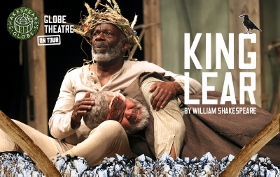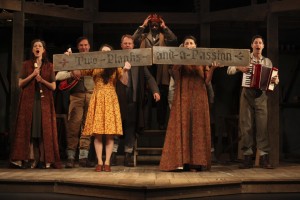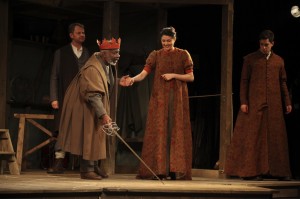MORE SINNED AGAINST
At one point in act four, the disillusioned and blinded Gloucester refuses help along the road: “I have no way and therefore want no eyes.” It’s a line that Bill Buckhurst would have been wise to cut before directing a King Lear as wayward as the one that has landed in Santa Monica.
It’s a difficult play: one of Shakespeare’s late, eloquent pessimisms, a story of a king who trusts the daughters he shouldn’t and banishes the one who loves him; of fathers betrayed by sons, of brother betraying brother; of madness, of folly, of despair. The few noble spirits that survive the carnage are so damaged by their experiences that a French invasion is a welcome distraction; news that a major character has died is answered, “That’s but a trifle here.” And like most Lears, this British production can’t quite contain Shakespeare’s sprawling drama and larger-than-life character arcs.
It’s very much a road show, in the tradition of traveling troupes, performed on a simple, one-piece scaffold-set by a versatile, disciplined cast of eight. With minimal props and small costume changes to mark multiple characters, these actors play instruments, sing a little, dance a little, provide sound effects and act very well. But they can’t do all that and direct it from the boards, too.
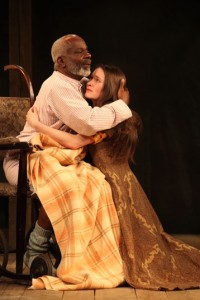 Buckhurst inserts the old saw about all you need to put up a play – “Two Planks and a Passion” – by having it painted on two planks, as he did when he and Globe Theatre artistic director Dominic Dromgoole presented their Hamlet here two years back. This gesture speaks to the company’s conflation of Poor Theatre with the Theatre of Whatever’s Handy. To wit: it’s very nice to have the actors onstage to create storm effects for the famous mad scene on the heath, and it’s fine to have a song (by Alex Silverman) performed every half hour or so. It’s amusing to have an actor play two characters in one scene by running catty-corner and taking off a hat. But why? Why do these things at all? What theme do they illustrate? What purpose? Why introduce a stylistic choice only to abandon it, or use it at random? If the point of the presentation is to emulate an historical traveling style, then it is successful in this, as the show is moderately entertaining in a typical, disappointing, “it was probably better in the West End” manner. But this would be a stupid premise, since it misses the central opportunity, which is to tell a particular story particularly well.
Buckhurst inserts the old saw about all you need to put up a play – “Two Planks and a Passion” – by having it painted on two planks, as he did when he and Globe Theatre artistic director Dominic Dromgoole presented their Hamlet here two years back. This gesture speaks to the company’s conflation of Poor Theatre with the Theatre of Whatever’s Handy. To wit: it’s very nice to have the actors onstage to create storm effects for the famous mad scene on the heath, and it’s fine to have a song (by Alex Silverman) performed every half hour or so. It’s amusing to have an actor play two characters in one scene by running catty-corner and taking off a hat. But why? Why do these things at all? What theme do they illustrate? What purpose? Why introduce a stylistic choice only to abandon it, or use it at random? If the point of the presentation is to emulate an historical traveling style, then it is successful in this, as the show is moderately entertaining in a typical, disappointing, “it was probably better in the West End” manner. But this would be a stupid premise, since it misses the central opportunity, which is to tell a particular story particularly well.
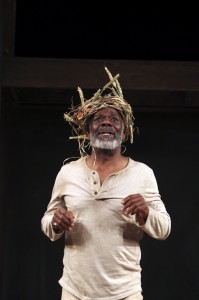 The message on those painted boards suggests an embrace of theatricality not much in evidence. The lighting (Jonathan Fensom) is purposely flat, in honor of the open-skied configuration at the Globe in London; the sturdy set’s second level is underused, with the action largely taking place downstage center; the built-in curtain, ignored for almost two acts, is employed at will and not always for good reason after intermission. In fact a fair amount of this show’s style flips and flops after the break. It’s much more jokey later on. Shanaya Rafaat’s Regan is presented more broadly in later scenes, delightfully so but at odds with the character’s pre-intermission incarnation; and the first half of this production would never have asked Daniel Pirrie’s Edmund to have an actual dialogue with the audience. But the second half does. It is rather too much to ask of an audience doing its best to stay rooted in one play, any play, that it root itself in all of these.
The message on those painted boards suggests an embrace of theatricality not much in evidence. The lighting (Jonathan Fensom) is purposely flat, in honor of the open-skied configuration at the Globe in London; the sturdy set’s second level is underused, with the action largely taking place downstage center; the built-in curtain, ignored for almost two acts, is employed at will and not always for good reason after intermission. In fact a fair amount of this show’s style flips and flops after the break. It’s much more jokey later on. Shanaya Rafaat’s Regan is presented more broadly in later scenes, delightfully so but at odds with the character’s pre-intermission incarnation; and the first half of this production would never have asked Daniel Pirrie’s Edmund to have an actual dialogue with the audience. But the second half does. It is rather too much to ask of an audience doing its best to stay rooted in one play, any play, that it root itself in all of these.
 These actors are very good, extraordinarily so by Los Angeles stage standards, and I encourage every American acting student to see this production as it continues its tour. The cast embodies an exemplary uniformity of talent and technique, and every actor needs to ask himself whether he’s going to get this good at dialect, at diction, at movement, at character delineation. But even good acting needs a director. This director allows his Lear, Joseph Marcell, to shout and froth at the mouth almost from the top. This is the same mistake you’ve seen directors make in Who’s Afraid of Virginia Woolf? when they let Martha begin at full volume, or in Hamlet when they let Hamlet mope on the battlements with Horatio. In a long play, you must give an actor somewhere to go. Marcell is otherwise an extremely interesting, dynamic performer, with great physical and emotional chops. But three hours is a lot of spitting.
These actors are very good, extraordinarily so by Los Angeles stage standards, and I encourage every American acting student to see this production as it continues its tour. The cast embodies an exemplary uniformity of talent and technique, and every actor needs to ask himself whether he’s going to get this good at dialect, at diction, at movement, at character delineation. But even good acting needs a director. This director allows his Lear, Joseph Marcell, to shout and froth at the mouth almost from the top. This is the same mistake you’ve seen directors make in Who’s Afraid of Virginia Woolf? when they let Martha begin at full volume, or in Hamlet when they let Hamlet mope on the battlements with Horatio. In a long play, you must give an actor somewhere to go. Marcell is otherwise an extremely interesting, dynamic performer, with great physical and emotional chops. But three hours is a lot of spitting.
photos by Ellie Kurttz
King Lear
Shakespeare’s Globe
Broad Stage in Santa Monica
scheduled to end on November 16, 2014
for tickets, call (310) 434-3200 or visit www.thebroadstage.com
tour continues through December, 2014
for tour info, visit www.shakespearesglobe.com
